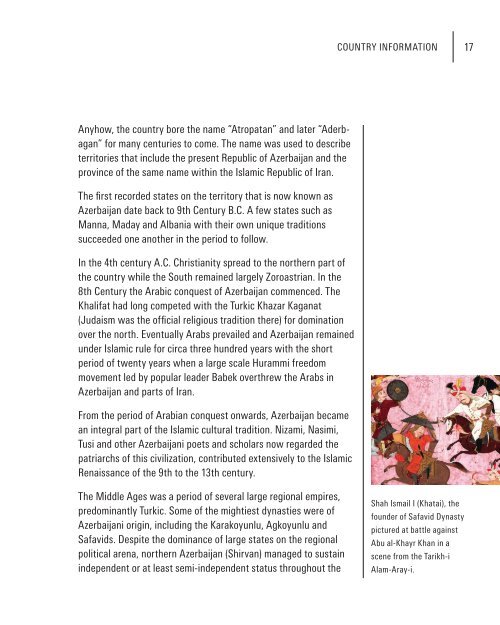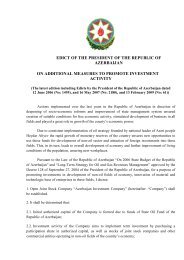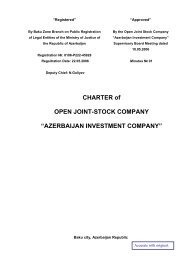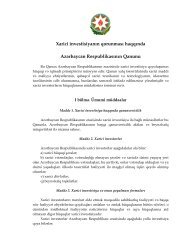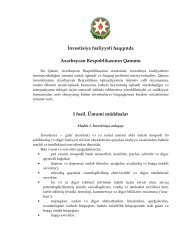Doing Business in Azerbaijan 2009 - Azerbaijan Export ...
Doing Business in Azerbaijan 2009 - Azerbaijan Export ...
Doing Business in Azerbaijan 2009 - Azerbaijan Export ...
Create successful ePaper yourself
Turn your PDF publications into a flip-book with our unique Google optimized e-Paper software.
Anyhow, the country bore the name “Atropatan” and later “Aderbagan”<br />
for many centuries to come. The name was used to describe<br />
territories that <strong>in</strong>clude the present Republic of <strong>Azerbaijan</strong> and the<br />
prov<strong>in</strong>ce of the same name with<strong>in</strong> the Islamic Republic of Iran.<br />
The first recorded states on the territory that is now known as<br />
<strong>Azerbaijan</strong> date back to 9th Century B.C. A few states such as<br />
Manna, Maday and Albania with their own unique traditions<br />
succeeded one another <strong>in</strong> the period to follow.<br />
In the 4th century A.C. Christianity spread to the northern part of<br />
the country while the South rema<strong>in</strong>ed largely Zoroastrian. In the<br />
8th Century the Arabic conquest of <strong>Azerbaijan</strong> commenced. The<br />
Khalifat had long competed with the Turkic Khazar Kaganat<br />
(Judaism was the official religious tradition there) for dom<strong>in</strong>ation<br />
over the north. Eventually Arabs prevailed and <strong>Azerbaijan</strong> rema<strong>in</strong>ed<br />
under Islamic rule for circa three hundred years with the short<br />
period of twenty years when a large scale Hurammi freedom<br />
movement led by popular leader Babek overthrew the Arabs <strong>in</strong><br />
<strong>Azerbaijan</strong> and parts of Iran.<br />
From the period of Arabian conquest onwards, <strong>Azerbaijan</strong> became<br />
an <strong>in</strong>tegral part of the Islamic cultural tradition. Nizami, Nasimi,<br />
Tusi and other <strong>Azerbaijan</strong>i poets and scholars now regarded the<br />
patriarchs of this civilization, contributed extensively to the Islamic<br />
Renaissance of the 9th to the 13th century.<br />
The Middle Ages was a period of several large regional empires,<br />
predom<strong>in</strong>antly Turkic. Some of the mightiest dynasties were of<br />
<strong>Azerbaijan</strong>i orig<strong>in</strong>, <strong>in</strong>clud<strong>in</strong>g the Karakoyunlu, Agkoyunlu and<br />
Safavids. Despite the dom<strong>in</strong>ance of large states on the regional<br />
political arena, northern <strong>Azerbaijan</strong> (Shirvan) managed to susta<strong>in</strong><br />
<strong>in</strong>dependent or at least semi-<strong>in</strong>dependent status throughout the<br />
COUNTRY INFORMATION<br />
Shah Ismail I (Khatai), the<br />
founder of Safavid Dynasty<br />
pictured at battle aga<strong>in</strong>st<br />
Abu al-Khayr Khan <strong>in</strong> a<br />
scene from the Tarikh-i<br />
Alam-Aray-i.<br />
17


